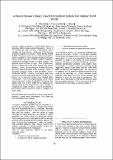| dc.contributor.author | Bharath, B. | |
| dc.contributor.author | DeepaIakshmi, V. | |
| dc.contributor.author | Nelson, I. | |
| dc.coverage.spatial | Brest | ru_RU |
| dc.date.accessioned | 2023-11-24T08:35:44Z | |
| dc.date.available | 2023-11-24T08:35:44Z | |
| dc.date.issued | 2006 | |
| dc.identifier.citation | Bharath, B. A Neural Network Based Speech Recognition System For Isolated Tamil Words / B. Bharath, V. DeepaIakshmi, I. NeIson // International Conference on Neural Networks and Artificial Intelligence : proceedings, Brest, 31 May – 2 June, 2006 / Edited: V. Golovko [et al.]. – Brest : BSTU, 2006. – P. 153–157 : il. – Bibliogr.: p. 157 (14 titles). | ru_RU |
| dc.identifier.uri | https://rep.bstu.by/handle/data/37195 | |
| dc.description | Бхарат Б., Дипайакшми В., Нельсон И. Система Распознавания Речи На Основе Нейронной Сети Для изолированных Тамильских Слов | ru_RU |
| dc.description.abstract | Speech recognition is always looked upon as a fascinating field in human computer interaction. It is one of the fundamental steps towards understanding human cognition and their behavior. White most of the literature on speech recognition is based on Hidden Markov Models (HMM). This paper presents a neural network approach for speech recognition in Tamil language.This paper proposes a neural network approach to build a speaker independent isolated word recognition system for Tamil language. The proposed system includes six steps. First, preprocessing step is to denoise the input speech signal using wavelet transform. Second, the unvoiced part is removed by using the energy values and number of zero crossings. Thirdly, to do feature extraction based on Mel Frequency Cepstral Coefficients (MFCC). Fourthly, these feature vectors are normalized to reduce speaking rate specific variations of the features o f the phonetic classes using Cepstral Mean Formalization. Next, Self Organizing Map (SOM) neural network makes each variable length MFCC trajectory of an isolated word into a fixed length MFCC trajectory and thereby making the fixed length feature vector. Finally, the resulting fixed number of feature vector is submitted to a feed forward neural network in order to recognize the spoken words. | ru_RU |
| dc.language.iso | en | ru_RU |
| dc.publisher | BrSTU | ru_RU |
| dc.subject | Talim speech recognition | ru_RU |
| dc.subject | распознавание речи | ru_RU |
| dc.subject | noise removal | ru_RU |
| dc.subject | удаление шума | ru_RU |
| dc.subject | feature extraction | ru_RU |
| dc.subject | извлечение признаков | ru_RU |
| dc.subject | cepstral mean normalization | ru_RU |
| dc.subject | нормализация среднего значения | ru_RU |
| dc.subject | Self Organizing map | ru_RU |
| dc.subject | самоорганизующаяся карта | ru_RU |
| dc.subject | feed forward neural network | ru_RU |
| dc.subject | нейронная сеть прямой связи | ru_RU |
| dc.title | A Neural Network Based Speech Recognition System For Isolated Tamil Words | ru_RU |
| dc.title.alternative | Система Распознавания Речи На Основе Нейронной Сети Для изолированных Тамильских Слов | ru_RU |
| dc.type | Научный доклад (Working Paper) | ru_RU |
